 Naive, bewildered, clueless, but hopeful after high school
Naive, bewildered, clueless, but hopeful after high schoolAugust of 2012 represents my 30th year working as a software engineer. How it all got started was a harrowing adventure, amidst a brutal economic landscape in industrial America. Here’s my story.
I graduated in 1977 from the State University of New York in Buffalo with a B.A. degree in Environmental Design and Planning. And nothing happened….Nothing happened for many reasons, which I’ll explain later.
 Naive, bewildered, clueless, but hopeful after high school
Naive, bewildered, clueless, but hopeful after high school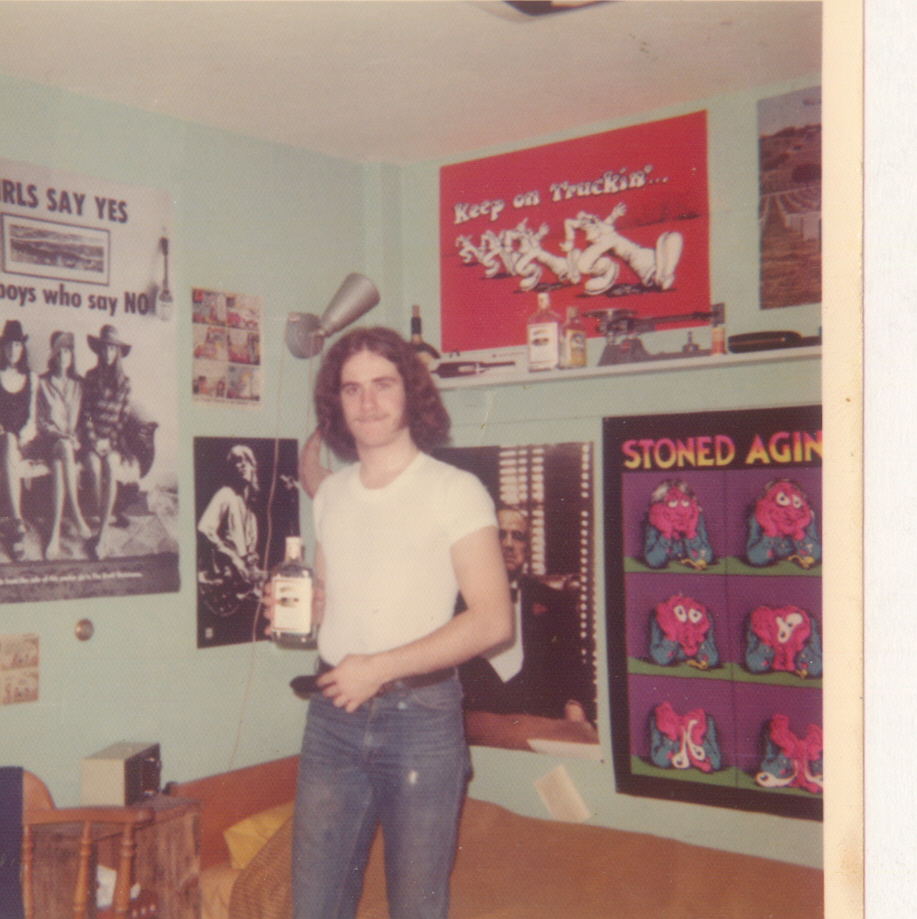 Partying hard at Clarkson. Check the posters behind me.
Partying hard at Clarkson. Check the posters behind me.As a youngster, it was clear that I had aptitude in math and the sciences and geared my college education towards an engineering degree – I was interested in environmental issues and thought I could use an engineering degree to help make a greener world. And my plans were all set – I was going to share a dorm room with a high school buddy at the Univ. of Buffalo and it would all be fantastic. Unfortunately I did not get into the U. of Buffalo (even though I had .1 less of a grade than my friend). So I settled for a private school, Clarkson College of Technology in the remote (and frigid!) village of Potsdam, NY, close to the Canadian border. The scene there was like a throwback into the 50s, sorta like Animal House or Happy Days. I was one of the few ‘freaks’ at this profoundly straight and jockish college.
It was at Clarkson that I suffered my first midlife crisis. Civil engineering was such a profoundly boring major to me that I soon realized I made a major mistake. And amidst the crisis, I took up a second major in sex, drugs and rock & roll…well, mostly drugs, specializing in all forms of cannabis and hallucinogens (Clarkson is renown for chemical engineers and some lucky engineer got his hands on a batch of lysergic acid, producing voluminous amounts of LSD). And I cannot forget a Kuwaiti friend with his hash-oil! But despite the purple haze, I did manage to make the Deans List in my second semester.
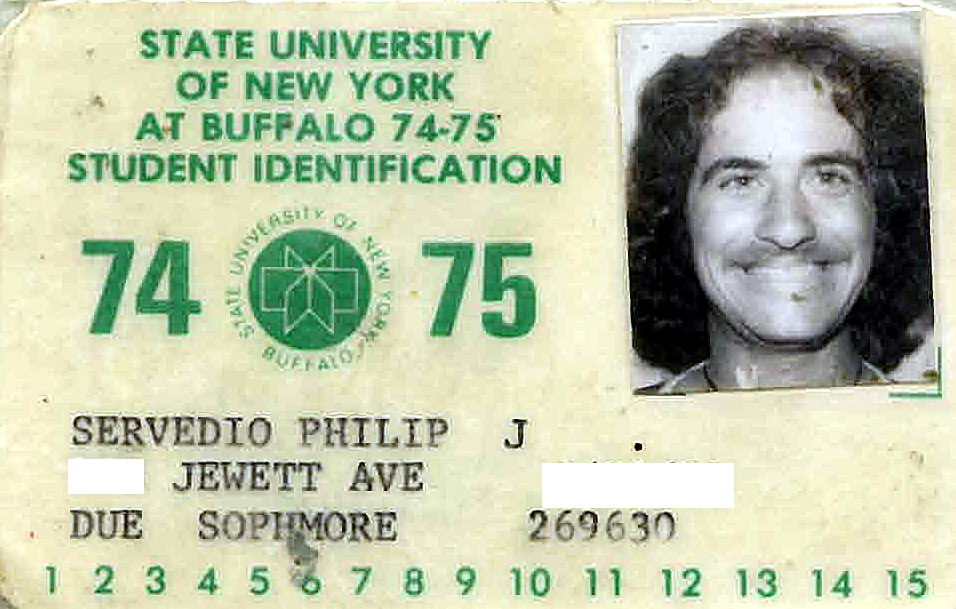 1974 UB Student ID Card. Very stoned here. Just cut my hair.
1974 UB Student ID Card. Very stoned here. Just cut my hair.And I did take some computer courses. However, you need to understand what computers were like those days...the processing power of your iPhone literally took a room the size of a small baseball field then. I remember writing programs on punch cards for the gigantic IBM 360 on campus, standing in line to submit the cards and getting rejected the next day if I had a syntax error in one mere card. Not exactly a model of efficiency...It also turned me off to computer science (lousy teachers didn't help either). I also remember paper tapes and teletypes with rolls of gray-brown or green-white paper. This was a small evolutionary leap in interaction with computers – I could type something in and the computer could answer me, generate programs, try to run them. It seemed revolutionary and so cool (but in retrospect, how cute, how ancient!).
But what really impressed me the most about teletypes was, hanging on the computer lab wall of this almost all-male school, a printout of a Playboy Playmate centerfold, her form made up of ascii characters. The work that went into generating that! But that was the dawning of the age of internet porn, the birth of the killer app!
 Cynthia Myers, 1968 Playmate. Found the exact poster after all these years.
Cynthia Myers, 1968 Playmate. Found the exact poster after all these years.After my crisis, I couldn’t decide what to do with my life, when my friend called me on day out of the blue and asked me if I wanted to share an apartment with him in Buffalo. So in November of ’73, I loaded up the truck and moved to Buffalo, into a lower-middle class mostly African American neighborhood on the east side.
The Scene in Buffalo
The early 70s were, in reality an extension of the 60s, very turbulent times in America and the world, utterly different than today. Among other larger, more global causes such as civil, women and gay rights, the Vietnam War, etc., many people were rebelling on a personal level against the strictures of narrow minded expectations left over from the 50s of “do four years of college then get a job at a company for 30 years”. And I certainly was not going to play that game and, like others, I wanted to “find myself” or simply understand myself and the world a whole lot better before I made large scale decisions that would affect me later in life. So I dropped out of school for a semester.
 Trico windshield wiper plant just down the block from my apartment
Trico windshield wiper plant just down the block from my apartmentThis action turned out to be one of the keys to my future, rendering a clue about myself and about America in general economically. After settling into our apartment on Jewett Ave in Buffalo (just a stones throw from the giant Trico plant, supplying the US with wiper blades), I set out amidst several feet of snow in the winter of 73-74 to find a job. My first stop was the unemployment office downtown and through a fortuitous set of lucky breaks, I ended up meeting with an extremely knowledgable and prescient employment officer. He must have had an economics background (or was extremely well-read), as he filled me in on the current job situation in Buffalo and in the US in general. I'll never forget one thing he said, quoting from a French economist: the USA and the west in general was beginning to undergo the process of transformation from a manufacturing economy to an information technology based one. Bingo. Clue number one. File that one away.
So I spent one semester as a shipping clerk at a company called Chippewa Instruments by day, party animal by night. Additionally, this “pause in the ladder to success” led me to perform a lot of soul searching and resulted in a personal spiritual transformation, and in a matter of months I cleaned up my act and began a spiritual life of meditation and other practices that parallel my 9-5 career, up until this day. After my semester break, I enrolled in the program of Environmental Design and Planning at UB, which was an adjunct to the architecture career. I was always interested in building and design, and due to my experience at Clarkson, I was temporarily turned off to science and technology.
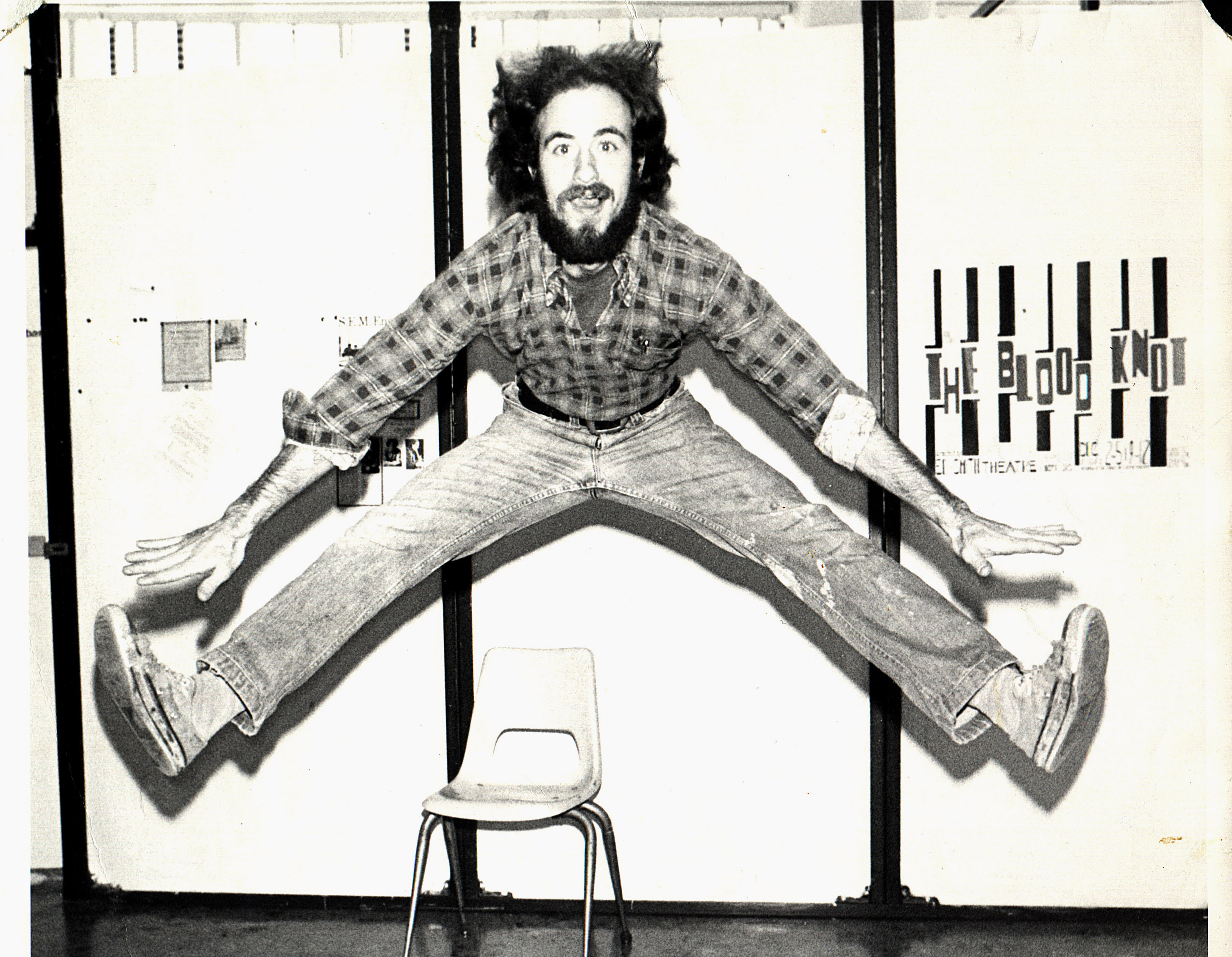 Jumping for joy at my college education at UB.
Jumping for joy at my college education at UB.The two years of my major in environmental design would supposedly result in a job in a design group or in the government as an urban planner. It was a fantastically creative curriculum, opening me up to the world of consulting work, which we did in several semesters as interns. For a group senior thesis, we developed a program for environmental clearing houses in cities, which in retrospect sounded like a desperate cry for Wikipedia and google in general.
The Economic Landscape of Industrial America in the late 1970s
So in June of 1977 I graduated with honors (so what, right, it's a B.A. Degree!), but several factors combined to result in practically zero chances for a job:
1. The baby boom grows up
The late 70s were the high point of the bell curve of baby boomers graduating from college, and it was impossible to absorb such large numbers into the economy. For example, my program was part of the architecture department in 1977, and in 1977 the colleges of the USA graduated as many architecture students as there were architects in the entire USA.
2. The Belt Begins to Rust
As the employment officer told me, American manufacturing was on the decline and information technology was on the way up. Buffalo, NY was one of the hearts of heavy industrial America, holding the 4th largest steel mill in the world, Bethlehem Steel in Lackawanna and employing tens of thousands in various kinds of heavy industry: Republic Steel, the Ford Stamping plant, Dunlop tires, Trico Rubber, National Gypsum, Hooker Chemical, Chevy Assembly, to name a few. Steel was the first industry to get hit by cheap labor based imports from the east, and Buffalo began a process of economic bleeding at the time of my graduation. Little did I (and my fellow Buffalonians) know that it would get incomprehensibly worse than imagined.
Too Soon
Plain and simple, the personal PC and the Mac were not invented yet. Information technology was still in its infancy. The boom was yet to hit. I didn't realize, upon my graduation, that I was waiting for its birth.
Post Graduation
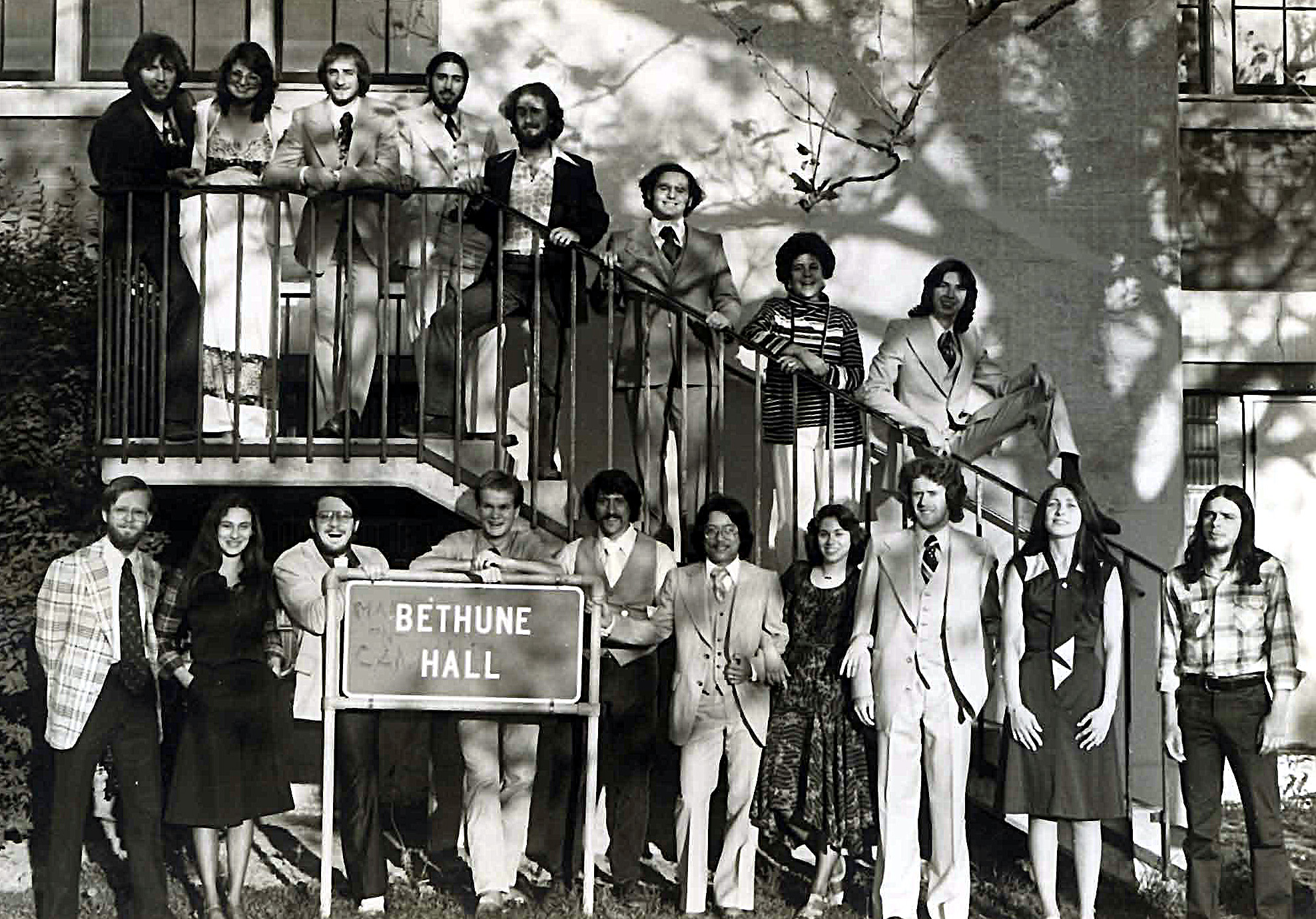 My 1977 graduation class, I'm 5th from left on the stairs
My 1977 graduation class, I'm 5th from left on the stairsIn the midst of my final year of school at UB, I was undergoing a spiritual transformation that became the major focus in my life. I lived in a spiritual ashram setting, had an Indian guru, spent anywhere from 3 to 8 hours a day in meditation, went on retreats around the world. But, of course, you still gotta eat and pay the bills.
Jimmy Carter opens the door...
The plight of the loss of the industrial and manufacturing base in America (which continues to this day) was not lost on the Ford and Carter administrations. So in the late 70s, Jimmy Carter created CETA, the Comprehensive Employment and Training Act, a kind of modernized New Deal government program to create jobs in distressed cities in America. And Buffalo was high on that list. Much of the money came from the federal government into community agencies to hire people in their areas of strength, and it seemed to make a small dent in the unemployment scene in Buffalo. But in reality, it was still not enough to compensate for the profound decline of the city.
Right after college I applied for employment through CETA and forgot about it. So I hooked up with a friend painting houses. We actually formed a painting company and stayed steadily employed.
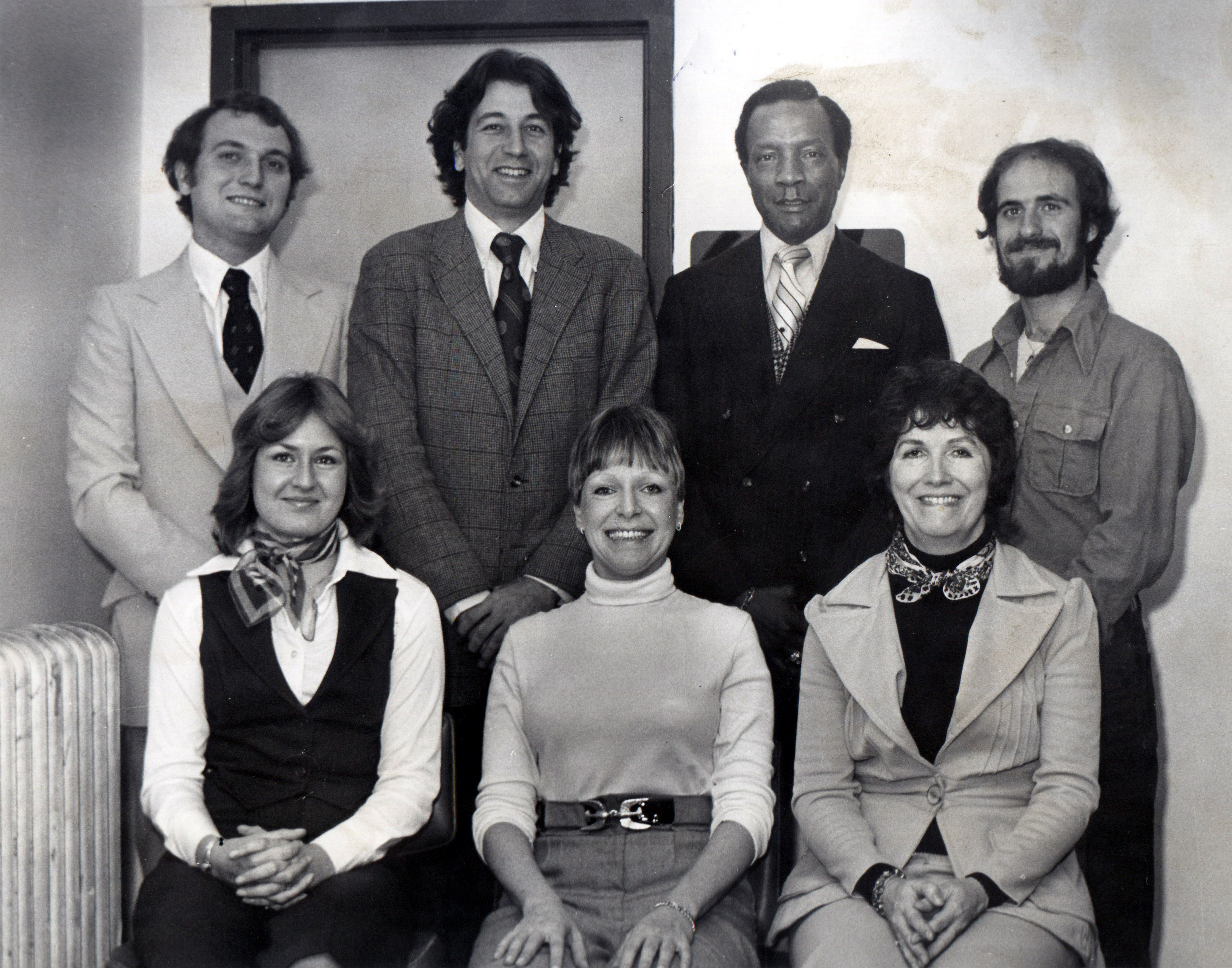 The gang at Allentown Association 1978.
The gang at Allentown Association 1978.In late summer 1977, while we were painting the home of the parents of my friend, I got a call from an employee at CETA stating that there was a job opening for me. How the employee got the number of the parents of my friend I'll never know, but in short time, after a short interview process, I took a two pronged job in the Allentown Association Agency – in the fall and winter I would be an associate handyman to help repair the homes of the very poor who needed it the most, and in the spring and summer, I would be a playground designer, and would design and build playgrounds in the many vacant lots of the Allentown area of Buffalo.
 My 16 year old Guru in 1974
My 16 year old Guru in 1974Allentown is an “historic” district of Buffalo, full of very interesting homes and brownstones with a long history, an area deemed worthy of upkeep and repair, like an old treasure. All cities have neighborhoods that have an intrinsic value that is not easily measured in dollar values and Allentown was one of these places. So I began my job in the agency, full of all sorts of newly hired characters recently fulfilling all sorts of desperate needs for the poor in Allentown. I worked with the construction project coordinator, and we went into these old homes, repaired floors, walls, ceilings.
What I saw was a level of poverty and economic depression that really made an impression on me, especially the poverty of the old and infirm. Many of these homes simply were full of cracks and holes in walls that let in the brutal cold of the Buffalo winter. One house in particular really struck me, a home of several blind men. It was utterly filthy, as these men could not see the years of grime on the counters, cabinet faces and walls, nor could they really see the dirt in all the corners, and apparently they had no one to help them but us. All they ate were canned goods because that was all they could manage cooking. Each cabinet had its own set of cans so they could differentiate one from the other (never found out how they were stocked). And then there was the old lady living in a freezing home because her floor was rotted out. We laid down 3 layers of plywood and masonite on her broken floor. It was heart-breaking. And this goes on all the time. Everywhere.
When summer came around, things got a little dicey with federal funds and the money soon began to disappear for my playground projects. I was left with a small set of funds to beautify several empty lots left in disrepair from demolished and razed home. It was something, but not much. After one year, all the money ran out and my CETA job was no more. So I went back to independent contracting.
Myself, my friend and another fellow in my spiritual group formed a construction company, B.H. Grace. I still have a few brochures after all these years, designed by a future girlfriend at the time. We hooked up with several carpenters in our group and we all specialized in the total experience of remodeling the many splendid but decaying homes in Buffalo. They wer large Victorian structures that we totally gutted, rebuilt and restored to the point of being worthy of a photo in House Beautiful magazine.
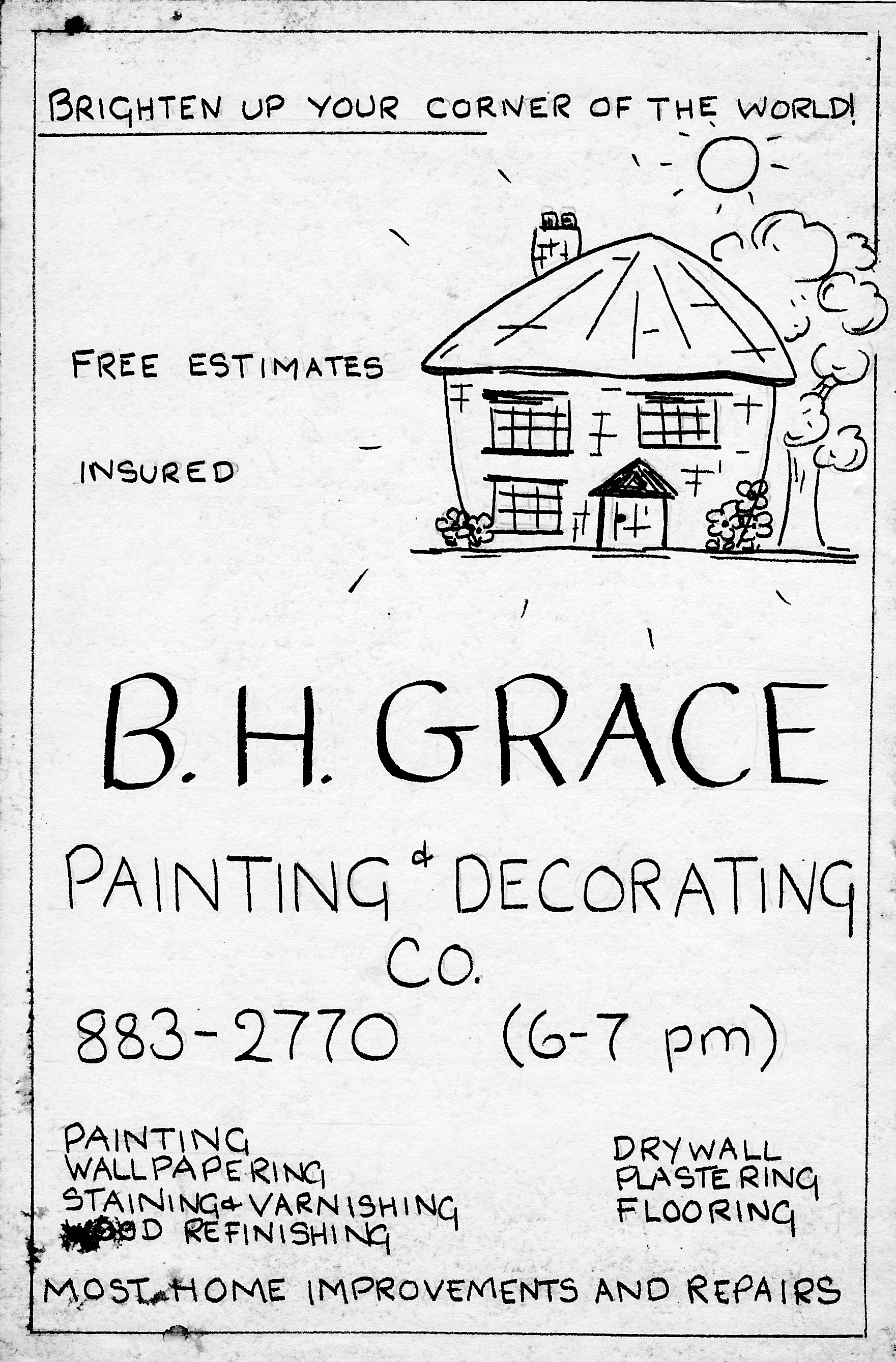 My Remodeling Company 1978.
My Remodeling Company 1978.Our little company specialized in finished drywall, painting, varnishing, some trim carpentry, everything post studs. We learned a lot on the job, and I became a “mudder” specialist, being able to apply drywall compound with such skill that I didn't need to dry sand it – I used a sponge to wet sand, saving my lungs from even more damage than they were already subject to. We also did exterior painting of many massive homes, painting on rickety ladders up to 3 stories. I even fell off a ladder once and landed right on my feet without spilling a drop of paint! Things went well for a year or so, as we remodeled a number of homes in Buffalo...
The Beginning of the Oxidation of the Rust Belt
But all good things must come to an end – many of my friends, along with thousands of others, moved out of Buffalo, as it fundamental base for decades, heavy industry, slowly began to die or move away. As my buddies left town, my little company ended up with an employee base of one. Me.
Post Graduation
 The behemoth Bethlehem Steel plant, overlooking Lake Erie in Lackawanna
The behemoth Bethlehem Steel plant, overlooking Lake Erie in LackawannaWhen I first moved to Buffalo in 1973 it was on the backend of its high peak of success – the steel mills were working feverishly, employing over 30,000 workers in over 50 mills. If you have never seen (or smelled) a steel mill, it is an impressive sight (and site). The big one in Buffalo was the massive Bethlehem Steel plant just south of downtown Buffalo hugging the Lake Erie coastline. Driving past it, you would find yourself looking at an almost endless building that was about a mile long (in actuality a series of buildings connected together). On warm summer nights, Bethlehem steel would open its big doors near the main blast furnace and it would light the western sky red late into the night. Do you remember the scene in The Lord of The Rings as the characters looked at the sight of Mordor in the distance with its telltale red glow in the sky? It was a lot like that.
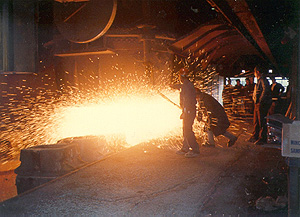 Next time you have a pity party about how hard your job is, remember these guys.
Next time you have a pity party about how hard your job is, remember these guys.And the environmental pollution was unmistakable. The air smelled acrid and burning even in my home in central Buffalo, and often, in the morning, I would find my car covered in a fine ash from the mills (we all could tell how well Bethlehem Steel was doing just by the smell in the air!). And the neighborhoods around the plant were something out of the worst documentary you've ever seen of Detroit post 2008. Ugly, dirty, the sun barely making it though the haze, a sense of gloom and worn-outness everywhere. The people who lived there seemed somewhat disfigured by living and working in these conditions, tremendously unhealthy. As Mordor had its orcs, Lackawanna had a population that seemed to me a little 'troglodyte'-ish. Bless them for the sacrifices they made with their lungs and bloodstream to give us the steel for our buildings, cars and ships.
I once had a chance to go inside one of these mills, a smaller one in central Buffalo. A friend was a night security guard in the mill and let us in to view the innards. When he turned on the lights in the massive building, I immediately felt a sense of disorientation, much like the tiny Gulliver in a land of giant people – everything was on a massive scale, giant cups the size of cars...cranes, huge conveyers belts and furnaces. And dirt and soot everywhere – I could only imagine the noise, heat and pollution that abounded in this place during a typical work day. Kinda made me glad I was going to college, with the hope of never having to work in such a place.
Well, over time, that hope became a non-issue, fortunately for me and unfortunately for the thousands that worked in these industrial complexes. When I moved to Buffalo in 1973, big steel employed over 30,000 people, 20,000 in just Bethlehem steel alone. When I left Buffalo ten years later, only 3000 people were left working in the few mills left. Bethlehem Steel finally closed its doors in 1984. To add insult to injury to Buffalo, Japan began to kick the ass of American automakers, further increasing unemployment as the car plants in Buffalo shut down or moved south.
 The Bethlehem Steel site today, razed to the ground, having gone bankrupt in 2001.
The Bethlehem Steel site today, razed to the ground, having gone bankrupt in 2001.More Economic Stress and Unemployment
In the post college years, my buddies and I had a steady stream of work – there seemed to be just enough people sufficiently wealthy to have their homes remodeled or need some form of improvement. As my buddies left, I took over the reins of the company hiring other spiritual friends and there seemed to be just enough work to make a living.
But as the 80s kicked in, I began to notice work was diminishing – my phone rang less and less. But something even more curious was happening when I bid on a job...since we were not a large construction outfit, my overhead was low and I was not particularly greedy. So I gave very fair bids for jobs. And I kept losing them. So I lowered my rates a bit more. And still kept losing the bids.
After a while, it finally dawned on me what was happening - what about all those unemployed workers of the steel mills? Well, even with unemployment benefits, they could not feed their families and pay their bills, so they themselves formed construction companies. Competition was fierce and brutal...and impossible when someone outbids you for a job in which they couldn't be making more than $4.00 per hour. Ridiculously low prices.
So my business slowly suffered the same fate as many businesses, feeling the downstream effects of increasingly massive unemployment and poverty that was besieging Buffalo in those times (and I believe for which it never recovered). My business dissolved as the quality and quantity of jobs were not enough for me to survive. But my skills landed me a job as a furniture refinisher and mover in a friend's used furniture company.
His business, Scotty's Furniture, was doing a booming business, as it purchased furniture and items from the thousands of homes of people who were fleeing Buffalo. I remember going on many buying runs and talking to the people leaving, moving to South Carolina, Texas, Florida, Georgia – the Sunshine Belt that held the possibility of steady employment in the 80s. I felt a twang of jealousy, as I sensed some hope of a better economic future for these people (not to mention much better weather) than I seemed to have.
Though I enjoyed working at the furniture store, I suffered some serious health complications; the years of paint and chemical fumes took a toll on me. Working indoors often with poor ventilation, I would get high on oil based paints. Many jobs required wood stripping – many dining rooms in these houses in Buffalo had wonderful wainscot panelling of oak, mahogany and other fine woods – we would cook up a special mixture of paint remover and Clorox that would strip the paint and bleach the wood at the same time. The toxicity of that is something awful, and I spent days, weeks breathing in such mixture in houses with, by our own poor decision making, poor ventilation. Either work in frigid conditions in the Buffalo winter or deal with some fumes. We chose the latter, being young and stupid.
Hitting Rock Bottom
It all came crashing down on me one night when my body simply gave out...I began convulsing and I felt like I was in some tunnel with the outside world far away. I was unable to sleep for over a day. I was freaked out and scared by my body's rejection of all the toxicity. It was a drastic wake-up call. I had no health insurance to speak of and a resultant trip to a clinic produced a diagnosis that it was all in my mind, which utterly pissed me off . So I began a series of fasting and diets, such as raw foods and macrobiotics, that seemed to have a very beneficial result, but also resulted in a massive loss of weight. At one point I went down to about 110 pounds, which is profoundly rail thin for a 5 foot 8 inch man. And I got so weak that I could no longer lift furniture well, so my boss gently fired me. It's not fun being fired, but in the end it was another moment of 'fierce grace' in my life.
Did you ever hear of the Zen story that goes like this about so-called bad events being good events? It goes like this:
Maybe
Once upon the time there was an old farmer who had worked his crops for many years. One day his horse ran away. Upon hearing the news, his neighbors came to visit. “Such bad luck,” they said sympathetically.
“Maybe,” the farmer replied.
The next morning the horse returned, bringing with it three other wild horses. “How wonderful,” the neighbors exclaimed.
“Maybe,” replied the old man.
The following day, his son tried to ride one of the untamed horses, was thrown, and broke his leg. The neighbors again came to offer their sympathy on his misfortune.
“Maybe,” answered the farmer.
The day after, military officials came to the village to draft young men into the army. Seeing that the son’s leg was broken, they passed him by. The neighbors congratulated the farmer on how well things had turned out.
“Maybe,” said the farmer.
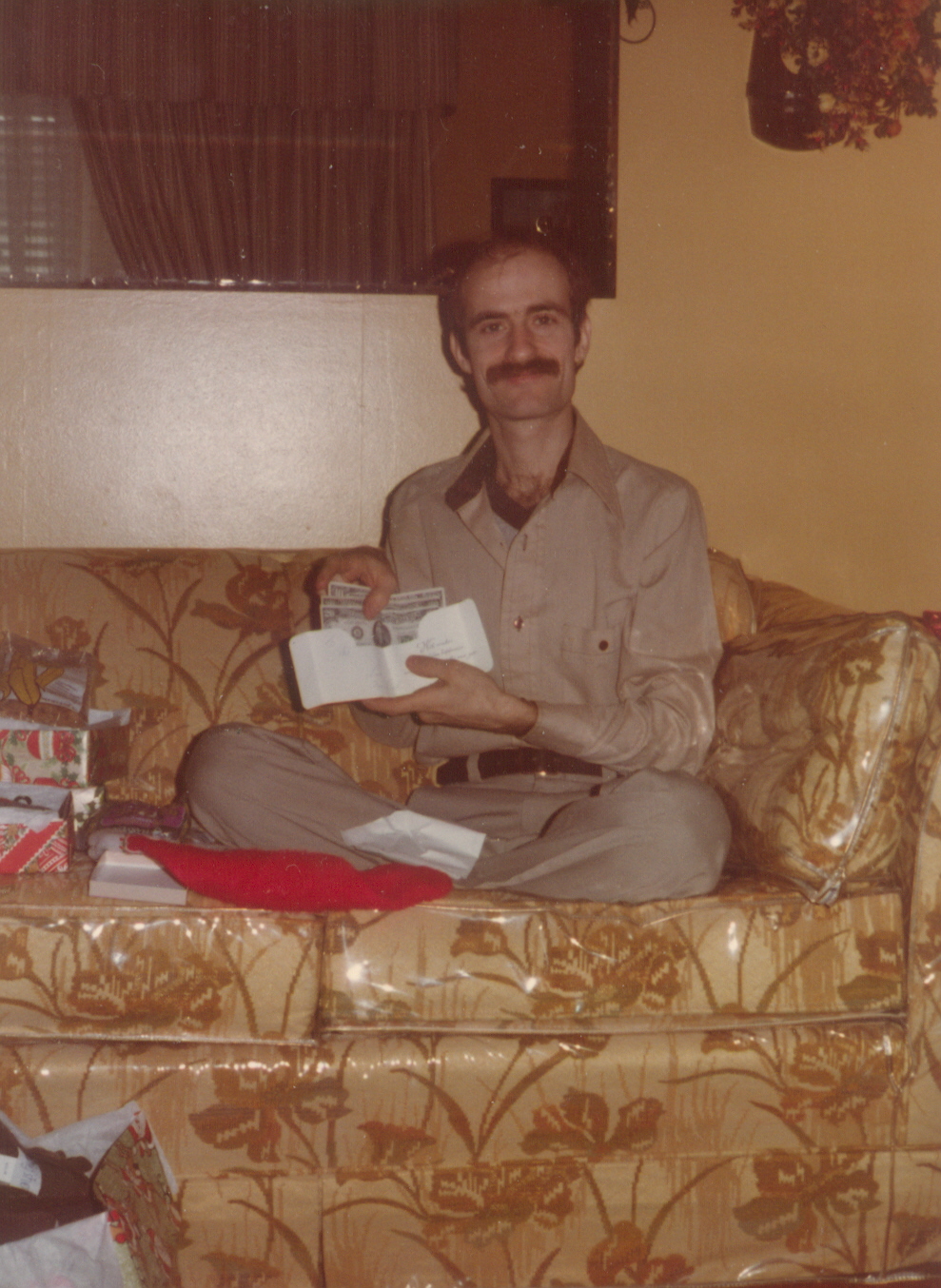 After a strict Macrobiotic diet, I went down to 110 lbs. I looked bad here, but I put on 20 pounds in the next 2 months
After a strict Macrobiotic diet, I went down to 110 lbs. I looked bad here, but I put on 20 pounds in the next 2 monthsOne of the nice benefits of being fired was being able to collect unemployment insurance, which gave me the time to get my health together and figure out what to do with my life. Over time, I took a lot of handy-man jobs to supplement my income, but my life seemed bleak, hopeless. I was poor, of suspect health, no girlfriend to speak of, living alone in a one bedroom apartment in the back of a house. Around Thanksgiving of 1980, I said to myself ENOUGH! ENOUGH! I AM GOING TO CHANGE MY LIFE, SOMEHOW SOMEWAY. I CANNOT GO ON LIKE THIS. I already have a college degree, could I leverage that to find a job? So I put my resume together and looked for positions in urban planning, but came up short. One really needed a masters degree in urban planning to even have a remote chance of getting the kind of job I wanted. I also went back and interviewed some of my college professors to see if they had any good ideas about what I should do. They didn't. I also applied for handyman jobs in community agencies and that also went nowhere. I needed a new approach.
Soul Searching
My initial search led me to What Color Is Your Parachute, a landmark book on job searching. It led me to a systematic search:
1) To clearly understand what I was good at and
2) Do what I have to do to further enhance what I find from #1 to land me a new job and career.
So I spent a lot of time writing, jotting down all the things that I have done in my life, no matter how small and insignificant the successes were, in order to find patterns of behavior and talent potential in me – I simply had to understand myself at a functional level in order to even begin a life change. I was about 27 at the time and going through this process, it was clear to me that my personality wasn't fully formed as a young man. It was a part of the process of growth and maturation that I was undergoing via some hard lessons.
But some patterns, abilities, qualities, etc, became clear as I went through this somewhat exhaustive exercise. And as I continued, the mystery known as “my future” began to take clear shape.My next step was to return to the University of Buffalo career placement office. I had found out that they offered career counseling. Some of the counseling involved taking tests to see what a person should specialize in. Some were vaguely helpful. But one test was striking to me: The Strong Campbell Interest Inventory Test. This particular test not only gave one a particular score in various categories of abilities, it matched those scores with working professionals to help give a person some insight as to a career choice. Clue #1 came easily from this test. I rocked in analytic ability and my score profile matched two professions very clearly:
Systems Analysts
Psychoanalysts
Hmmn, analyzing people or computers? Then I took another controversial step – I went to see an astrologer who specialized in career choices. Her response was sharp, clear and unequivocal, “Phil you've got to get into computer science”. Clue #2. (later in life, I studied Vedic Astrology and in understanding my own chart, it is really a no-brainer).
Meanwhile...
Meanwhile, as I was going through this soul and job search, somewhere in a garage in Northern California, Steve Jobs and Steve Wozniak were designing the Apple I computer, and engineers at IBM were outsourcing their operating system work for a revolutionary new thing called a Personal Computer to a small company in Seattle called Microsoft...
Reverse Interviewing
After a bit more time, it was clear to me that I would embark in a new career choice of computer programming. But before I did that, I took the advice of the author of What Color is Your Parachute: really investigate, what are the day to day duties of the person of the career of your choice? Don't you owe it to yourself to do a little research to find out if you resonate with the kinds of tasks that you will be doing for a majority of your waking life for possibly the rest of your life? I sure did, and I wanted to be absolutely clear on what I was getting into before I took the step of re-training for computer programming.
So I sought out several computer companies in the area and boldly walked up to the main secretary and asked them “could I see a computer programmer because I was about to become a computer science student and really wanted to know what they did all day”. The secretaries looked at me as if I had a 2nd head, but because it was such a novel request and I seemed sane and sincere, I did get to speak to one programmer and one systems analyst. The programmer stuff sounded more interesting, more detailed and and complex to me. They were both intrigued by my curiosity and wished my the best of luck.
I looked into the computer science departments of several colleges in Buffalo and saw that I would have to spend another 2 years in school for yet another Bachelor's degree with a hefty number of student loans, on top of the ones I already had, which didn't sit well with me. But I had time to dwell on this before I applied to a particular school.
...and Ronald Reagan ushers me through the door
So I went back to doing painting and the odd job to support myself in the midst of an economic calamity in Buffalo. In 1980, the official unemployment rate for Buffalo was stated at 13% but I knew that was bullshit, it was more like 30% as the people who no longer could receive unemployment benefits or were partially employed (such as myself on both counts) were not counted.
Then one day Ronald Reagan sent me a letter (ok, it was just someone in his administration) informing me that Jimmy Carter's CETA was being phased out, but I was eligible to apply for one year training programs in a new agency called the Private Industry Council. It was a similar federal “stimulus” package like CETA, but with an added twist, which went like this:
The federal government, through this new Council, would give grants to private employers to train people in their areas of specialty. Additionally, those applicants who were successful in obtaining the limited number of spots in each training program were to be given a salary while they were training. Sounded great!
Upon reading the training program catalogue, I started foaming at the mouth when I read about a special training in real time programming. I didn't know exactly what that was, but it was a doorway into the world of computer science paid for by the federal government. What's not to like? Real-time programming is the low-level development of software for various micro-chips that receive input from the real world, used in both military and civilian applications, ranging from guidance systems on a cruise missile to a 10 dollar digital thermostat.
The training program was hosted by a company called CompTek Research in downtown Buffalo – they specialized in software development for various devices for the Aegis defense systems on Navy ships. The company expanded its building to make way for a training center, and this was to be the second class. In order to get into the program, one had to be a college graduate, had to take the equivalent of a SAT test and pass a couple of interviews. But I was told that the test was the big hurdle to enter the program which had only 22 slots that year.
I was so excited about this that I tried to stay calm in the more likely event that I wouldn't get into this program, which I applied for in haste. And I waited for a response from Ronnie Reagan to tell me the time and place of the training program test. And waited. And waited. Nothing.
The phone call that changed my life
After some time I was getting a bit nervous about the lack of response, so out of the blue, one Friday, I called the Private Industry Council office in Buffalo and the conversation went something like this:
“Hi I'm Phil Servedio, I applied for the real-time programming course starting in September”
“Yes, I can see that you applied.”
“I'm waiting to hear from you about the test.”
“Uh,excuse me, didn't you receive the information in the mail that was sent?”
“No, why?”
“The test is happening in one hour”
“WHAT?
I had time to make it, so I got the information from the secretary, washed up and raced to the Erie Community College gym. When I entered the gym I was awestruck at the site, the entire gym was full of chair, totaling over 400 people trying to enter the training program. 400 college graduates, as desperate as I was for this one big break.
I freaking aced the test. I killed it.
There was no time to prepare and perhaps that was a saving grace for me, as I did especially well on the logic section that weighed heavily on entrance into the program. When I got my test results, I was floored...I never dreamed that I had done that well, and now I was thinking that destiny had just hit the autopilot (or was it or is it always on?).
I had a great interview with Sean McGarrigle, the program director at Comptek Research. In short time, I received a phone call from Sean that I was accepted! Out of those hundreds of applicants I got one of those 22 spots. My life was about to radically change. This felt like landing that big job, or making that chorus line on Broadway or making the first-string cut on a sports team all rolled into one.
Back in School
The program was intense but laid out the basis for becoming an effective real-time programmer. The program, lasting a year, was laid out to have 4 hours of classroom training in the concepts of computer science and real-time programming, and 4 hours of lab work daily. The computers were Data General minicomputers with (how quaint) a bunch of VT220 terminals in a lab room. And to top it off, I got paid $150 a week to get trained.
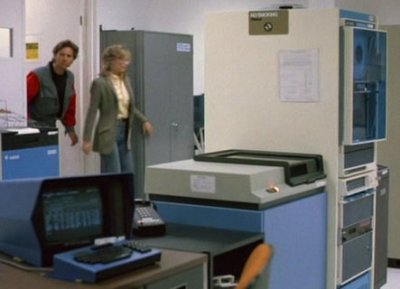 Data General Eclipse Min-computer used in our training lab, similar to a DEC PDP-11. This pic of the Eclipse is from the movie Tron in 1982.
Data General Eclipse Min-computer used in our training lab, similar to a DEC PDP-11. This pic of the Eclipse is from the movie Tron in 1982.The 22 positions came from folks from all walks of life, each with a story of economic hardship. There was Emily, who paradoxically was fired by Ronald Reagan because she was an air traffic controller and was fired in their famous strike. There was one genius kid, Don, who was numero uno in our class, so smart that he could play 10 chess games simultaneously and win them all. And he did it one day in our class, against students and teachers. Then there were two musicians in our group both of whom showed surprising prowess in programming, which led me to believe that the logic needed to read and transpose music to the fingers somehow used the same portion of the brain used in logic processing for writing software.
There were 3 teachers in the class, all employees of Comptek with experience in the software industry. One teacher in particular stood out, Candace, who was not only a fantastic teacher, she was a smoking hot blonde on whom all the boys in class, including myself, had one level of crush or another. And one lucky guy, Dick, in our class did end up with her by the end of the year. She wore a crew cut as a hairstyle, and you gotta be good looking to carry that style. Unfortunately, the poor woman developed cancer in the middle of our program, but soldiered on and kept teaching us right through chemotherapy. Wow.
The level of
desperation and suffering that I had undergone in the previous few
years had filled with a profound inspiration and thirst to do this
and do this right. There's a spiritual saying in Sufism that goes
“the right time, the right place, the right teacher”, and this
was certainly apt in my case. Not only was I utterly dedicated, I
seemed to have developed a pretty good knack for writing code and I
liked it, a total contrast to my first experiences in the paleolithic
age of computers back at Clarkson College in 1973. The curriculum
focused mostly on assember programming, with a lot of Fortran. My
favorite class was a tour of the many common and obscure languages
extant in that day. We wrote the same program in Lisp (car
(cdr '(1 2 3)));
yikes!), Ada, COBOL and SNOBOL. I
finished third in the class, right behind brilliant Don and Emily.
However, I did fuck up the Towers of Hanoi programming challenge.
There were some interesting dramas in the class. For one, many folks in the the class before us had a superior upper-classman attitude towards us, as if we were teenagers back in college. Like, WTF? Some wouldn't even socialize with us. But when they arrogantly challenged Don to a game of chess, he cleaned their clock. It was beautiful.
And besides the Dick and Candace romance, there was the drama of one of the teachers running off with a married woman in the first class, and another teacher being fired for incompetence. Then there was one guy in our class, nice guy, who also greeted people with “hey bucko!”. So one day, when we were trying to crack people's password, we tried to crack this fellow's password. We tried “bucko”, got in and messed up his file system seriously.
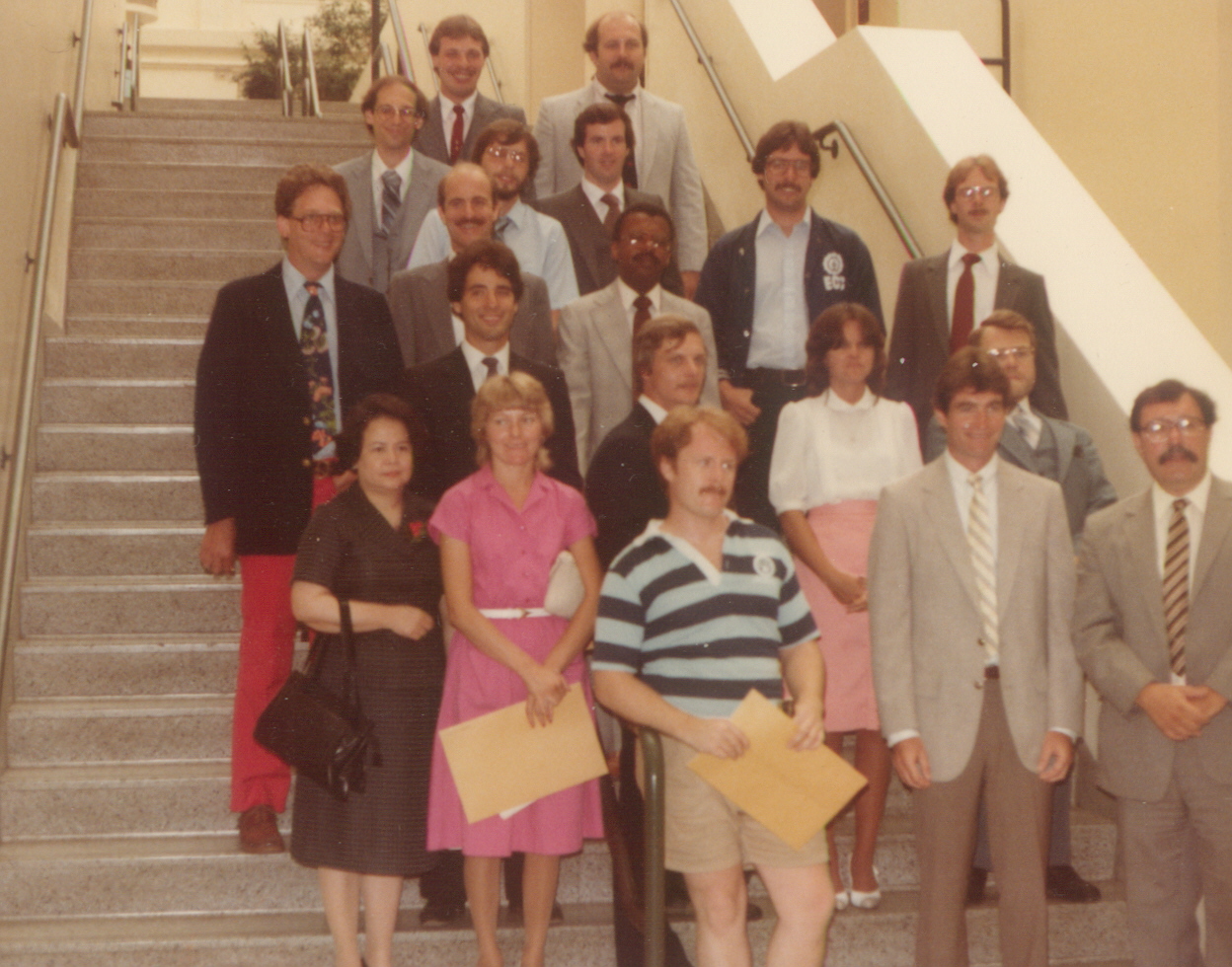 Graduating Class Comptek Research 1983
Graduating Class Comptek Research 1983As the year progressed, the upper class folks left, one-by-one, simply because they had found a job before their year had ended, which was a great inspiration for us underclassmen. I had progressed from “hello world” to some pretty complex programs, but in contrast with some computer science courses in college, I didn't have to pull all-nighters. I couldn't, our building closed at night.
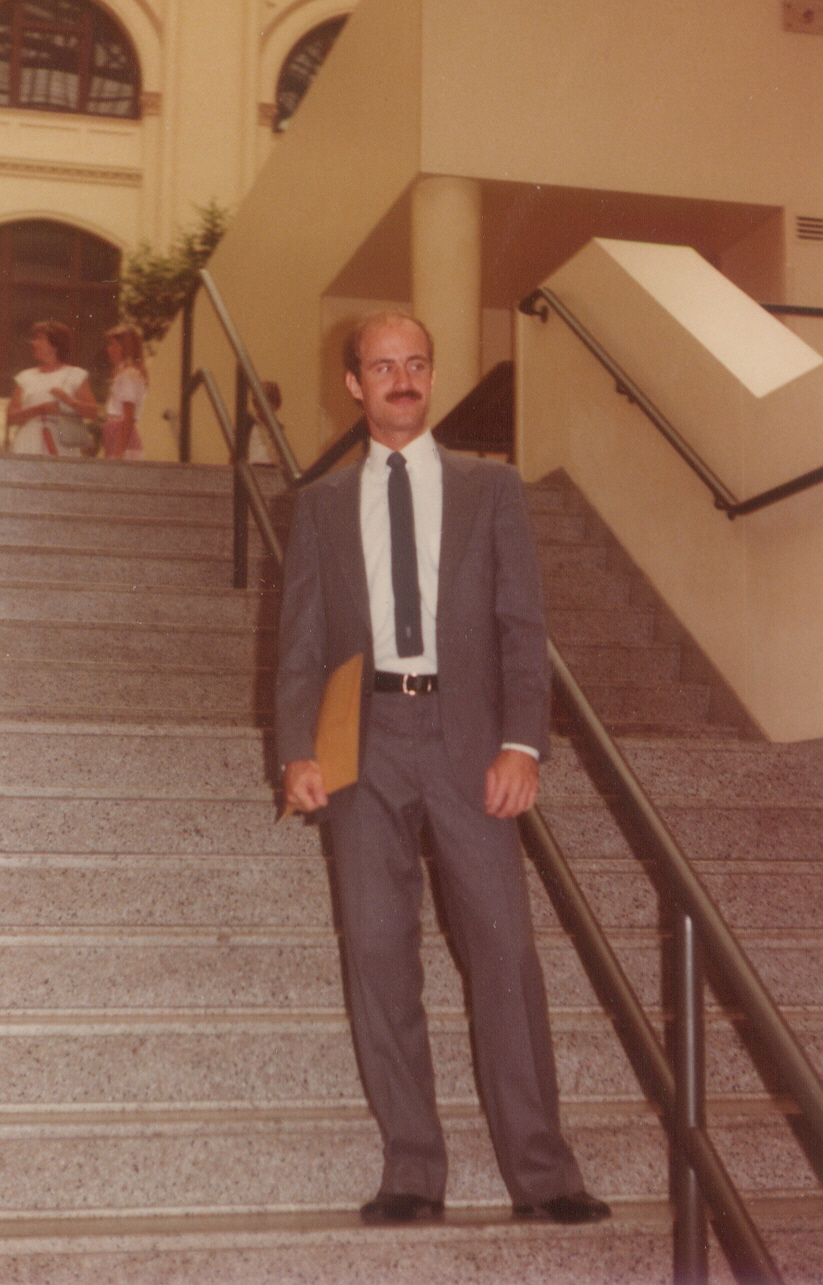 Phil at Graduation. Ready to kick ass and take names.
Phil at Graduation. Ready to kick ass and take names.One of the highlights of the course, at 9 months, was internship with a real company, something fairly new in the computer world. There was no lack of companies willing to take on a newbie that was trained in a course specifically made for job readiness in the world (again, perhaps, in contrast with computer science curriculums).
The Real World
Being one the top guns in my class, I had no problem hooking up with a software company in Buffalo. I had one interview with a company literally right next to the airport, Sierra Research, and landed an intern position there - which lasted two months, and they offered me a job for the grand sum of $19,000. $19,000! Wow, so much money!
I was in the civilian section of the company, building software in devices for all kinds of toll collection equipment for a new digital highway system for the state of Indiana. All assembly level programming on an 8 bit Motorola 6800 processor.
So that is how my life changed. It took two presidents and one timely phone call to turn me around. And I had no idea, none whatsoever, what lay in store for me technically, personally, geographically, socially...all because of this profound piece of good fortune in the early 80s, just as Steve Jobs and Bill Gates were about to blow the doors off the business world.
 Soon as I graduated, I bought my first new car. With my girlfriend at the time Lynette.
Soon as I graduated, I bought my first new car. With my girlfriend at the time Lynette.And the irony is not lost on me that it was Ronald Reagan, a president who campaigned on the slogan “government is not the solution, it is the problem”, who paradoxically (or hypocritically), agreed to a large scale Keynesian style federal government program to stimulate the recessive, or in the case of Buffalo, depressive economy. In fairness to Ronnie, he did have a practical side and actually worked well with Tip O'Neil to hammer out some well-functioning compromises, such as the public-private partnership of the Private Industry Council. He even raised taxes. A far cry from what we see today. On the other hand, he is the godfather of the massive mess of government debt we now face.
Some Perspective on 1982
30 years is a long time and the advances in computers, processors and technology in general has been nothing less than startling. When I began working in 1982, the computer world was changing dramatically. As one of the first waves of Moore's law kicked in, multi-user microcomputers began their reign as king of the computer world, replacing the mainframes with brands such as IBM, Burroughs, CDC, Honeywell, to name a few (not that they went away, they lived a long life after 1982).
But in the 1980s Digital Equipment Corporation (DEC) was the leader in the minicomputer revolution, with it's PDP series, and of course the DEC VAX. Other notables were Wang, Hewlett Packard (HP), Data General, etc
But still, despite this generational leap in smaller processing, computer science was still in its infancy or toddler stage. IBM just released the PC in late 1981, but it ran without a hard disk (I actually bought and used one) and the Mac wasn't out yet. But to give you some perspective on the time, here is a list of notable contributors to the world of software, the internet and the world wide web, and what they were doing when I first entered the software world:
Bjarne Stroustrup, the father of C++, was finishing up his Bachelors degree in math in Denmark
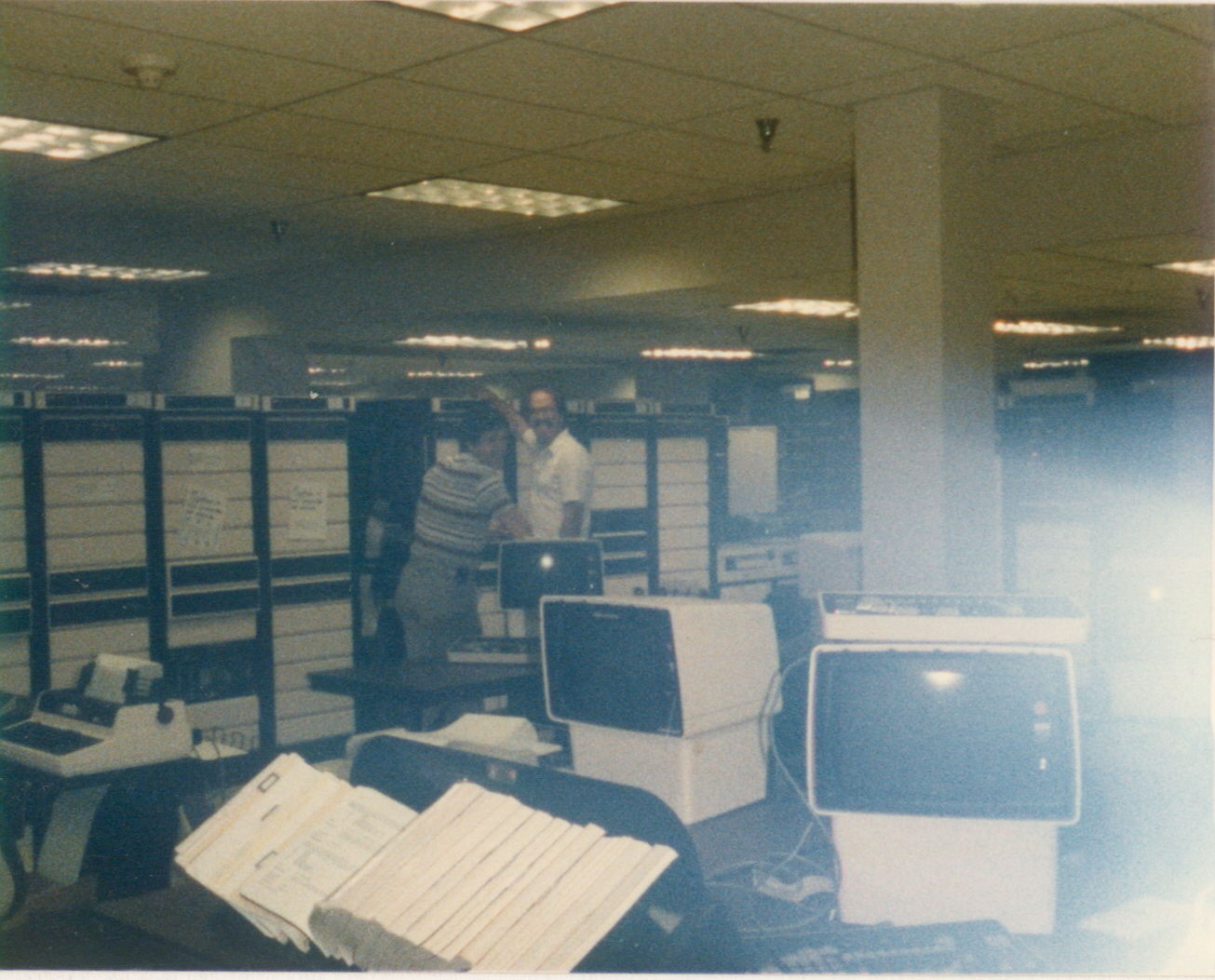 1980s style computer room, Computer Consoles. Secured with Halon gas.
1980s style computer room, Computer Consoles. Secured with Halon gas.Mark Andreesen, the inventor of the web browser, was 1 year old.
Mark Zuckerberg, the founder of Facebook, was not even born yet. Perhaps his parents hadn't even met yet.
Jack Dorsey, the founder of Twitter, was entering second grade.
Time Berners-Lee, the inventor of the http protocol and the world wide web, was getting his B.S in Physics at Oxford University
James Gosling, the father of Java, was working on his B.S in Computer Science in Calgary.
Sergei Brin and Larry Page, the founders of Google, were in grade school.
Linus Torvald, the inventor of the Linux Operating System and git, was in Junior High School
Dennis Ritchie was cleaning up the bugs in a new operating system called Unix. And a little programming language called C.
Brian Kernighan was helping Dennis Ritchie with Unix, writing sed, awk, grep and cron utilities. He, BTW, coined the term WYSIWYG and 'Unix'
Larry Wall, the inventor of Perl, was in graduate school at UC Berkeley
Al Gore was just learning about a military project called ARPANET, which later became the internet, when he introduced the High Performance Computing Act of 1991.
Keeping Up with New Paradigms in Software
Those 30 years have gone by scarily fast and now I see that the light at the end of the retirement tunnel is much closer than the starting gate in my rear view mirror. We've all heard about the world being fast paced and “what have you done for me lately” - this is never so true in the software world. There is a almost constant need to keep up with the latest trends in software in order to keep oneself relevant and highly employable. Just ask an old COBOL programmer.
Personally, I've re-invented myself a number of times as the software world evolved – I was fortunate enough to be involved in companies dedicated to training their employees with leading edge technologies, or I have made fortuitous jumps to new companies.
Here is a rundown of the leaps that I've made in the software world:
When I started out at Sierra Research in Buffalo, I worked building software on the 8-bit Motorola 6800 processor, with a dazzling speed of 1Mhz (one!). I had two address registers, A and B, and one 16 bit index register X. It could address 64K (not M) of memory. You learned to be efficient with your lines of code in those days (true today also, but for different reasons).
 Women developers are still rare, and also a real looker is even rarer. My old fried Robin was definitely one. With her 1st child.
Women developers are still rare, and also a real looker is even rarer. My old fried Robin was definitely one. With her 1st child.But one
interesting thing happened there that also has had a profound impact
on my professional and technical life. After Sierra Research decided
to shut down its civilian division, I was transferred to its main
military wing to work on radar software for the F15. However, I
chose never to work for the defense industry and put out my resume
shortly.
But, in the 2 intervening months, I was introduced
to the Unix operating system. Unix, in general, is one thing
that has not basically changed in all these years. It was
revolutionary, they got it right from the start, and after 30 years,
I am writing this on a Mac-book pro, which has a variant of Unix
running internally.
After 1 year at Sierra Research and due to my new Unix skills, I got an unsolicited call from a recruiter who talked me into moving to a company in Rochester (to the dismay of my girlfriend) named Computer Consoles. There I programmed on the 8-bit Intel 8085 and the 16-bit, 8086 then later on the Intel 80186, as Moore's law kicked into effect again. At Computer Consoles, I learned about the beauty of the DEC PDP-8 and PDP-11 machines.
After 2 years at Computer Consoles, I decided to move to Boston, MA, which happened to be a booming high-tech corridor. I again moved for personal (spiritual) reasons, and fortunately, my old boss at Computer Consoles moved to Boston 6 months prior. I called him up and had a new job in one day at a company called Atex. It was there I abandoned almost eveyrthing I knew about assembly language programming to begin a journey in higher level languages. I spent the next few years doing C programming, with a healthy dose of Unix c-shell scripting.
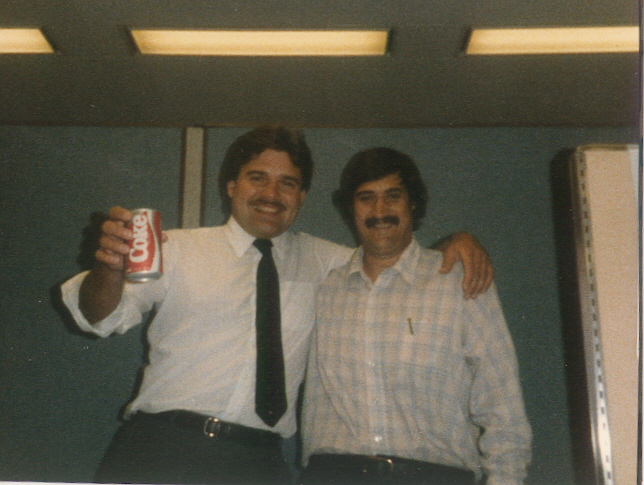 My Boss Alex Huppenthal and Don Drasch, Computer Consoles 1985. Alex once let me fly his private prop plane. Cool.
My Boss Alex Huppenthal and Don Drasch, Computer Consoles 1985. Alex once let me fly his private prop plane. Cool.In 1990, we (now a we, I met my wife in Boston) moved to California (also for spiritual reasons) and at Bell Atlantic Healthcare Systems (later Oacis Healthcare) I began my career with object oriented programming via C++. It was also there that I began a specialization in server software, as well as SQL and HTML and CGI programming for nascent internet based applications.
In 1999, as Oacis was dismantled by an evil parent company, I helped form an R&D department in a new startup called Fast Track Systems. It was there I abandoned C++ for programming in the Java world, with a side dose of C#, Perl, ksh scripting, CSS, and Javascript.
In 2009, as Fast Track was purchased by Medidata Solutions, I moved from the Java world to Ruby On Rails programming in the context of a cloud architecture, which continues to this day.
Each one of the above steps kept me on a leading edge of the software world and propelled me for the next big thing, the next paradigm. What is next, I do not know, but there will be one.
Personal Highlights and Other Lucky Breaks
In my 30 years of employment, I was fortunate enough to work on some highly visible and leading edge applications. Additionally some really cool events occurred to really stand out, which points to some great luck, great associates and some out of the box thinking.
As I stated above, my transfer to a group at Sierra Research in Buffalo in 1983 allowed me to learn Unix, which propelled me to two future jobs.
At Sierra Research I wrote software for a bar code reader. Interesting, simple technology.
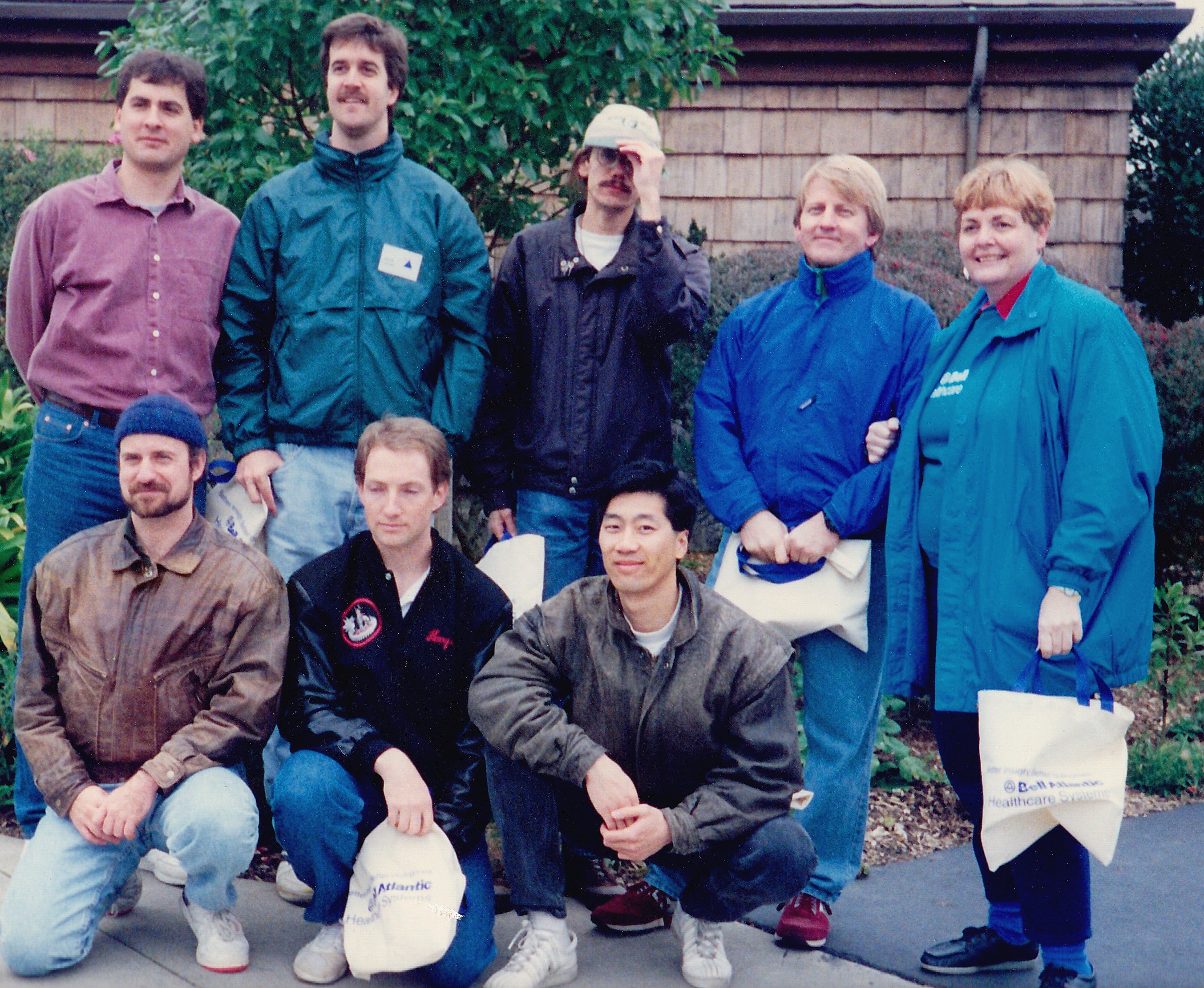 Part of the Bell Atlantic Healthcare Crew 1992, Bodega Bay Company Retreat
Part of the Bell Atlantic Healthcare Crew 1992, Bodega Bay Company RetreatIf you happened to have driven through the state of Indiana on a toll road in the 80s or 90s, you probably have interacted with software that I helped write in the toll collection equipment, especially the sensors that figure out how many axles your car has, and receipt printer.
At Computer Consoles, I worked on a leading computerized edge Directory Assistance application. At the time there were a few out there, and most sounded like Stephen Hawking's sister. Ours employed more sophisticated software helped by Ph.Ds in linguistics. Each digit in a telephone number has a certain cadence, and when done correctly, it sounds like a real human being. In fact that human being was the voice of an employee and resident of Rochester, NY, Terry Ann Hartman-Sax. It was calculated that she was the most listened to voice in the world at that time, and she even went on the David Letterman show. I worked on an assembly language program that billed the customer for the call, called D.A.-Charge.
In my four years at Atex, I eventually specialized in the effort to move its large minicomputer system to a client-server architecture, using the nascent PC as a client and a Sun Workstation as a server. I ended up as a one-man group developing the server software. When I gave notice in 1990 (as part of my move to CA) the vice-president of my division came in to my cube, got on his knees, put his hands together in prayer and squeaked “Please don't go!”. I'm not making that up. And on the last day of my job, they sent me to Manhattan to the offices of Time and People Magazine to fix a bug.
In 1991, I
worked with friends in a company that developed FoxPro software
developing corporate real-estate software on the earliest of
Macintoshes. When the company started going south, I updated my
resume, hoping to get back into the Unix server programming world.
 Bell Atlantic Softball Team 1994. I played 1st base, even did a split once. My hand still hurts from the rockets from Dan Neff at 3rd base.
Bell Atlantic Softball Team 1994. I played 1st base, even did a split once. My hand still hurts from the rockets from Dan Neff at 3rd base.If you've been admitted to one of a certain number of hospital in the US in the 90s, your electronic medical record probably has passed through server software that I helped write.
Bell Atlantic
turned into Oacis Healthcare Systems, and 5 years later in 1996, a
buddy at worked said to me, “You know, Phil, it would be cool
if we could convert our main app into a web application” (it
was a heavyweight PC app). It set off a light bulb in me and I began
a personal skunkworks project, interviewing developers as to the
details of the app, and eventually developed a prototype web app
using HTML and CGI. I demoed the app to the executive team. They
went apeshit. They were woken up to the future.
A whole new
group was formed to develop this new web app. The executive team was
so excited by this new prospect that they invited me to sit in on a
their team meeting to learn how they were going to price the new
software. At one point they actually gave me an ovation, I'll never
forget it. The new project was called Spider and I was nicknamed
Spiderman. Of course, the web world was so new we had to build our
own application server - Jboss, WebSphere or Weblogic didn't exist
then.
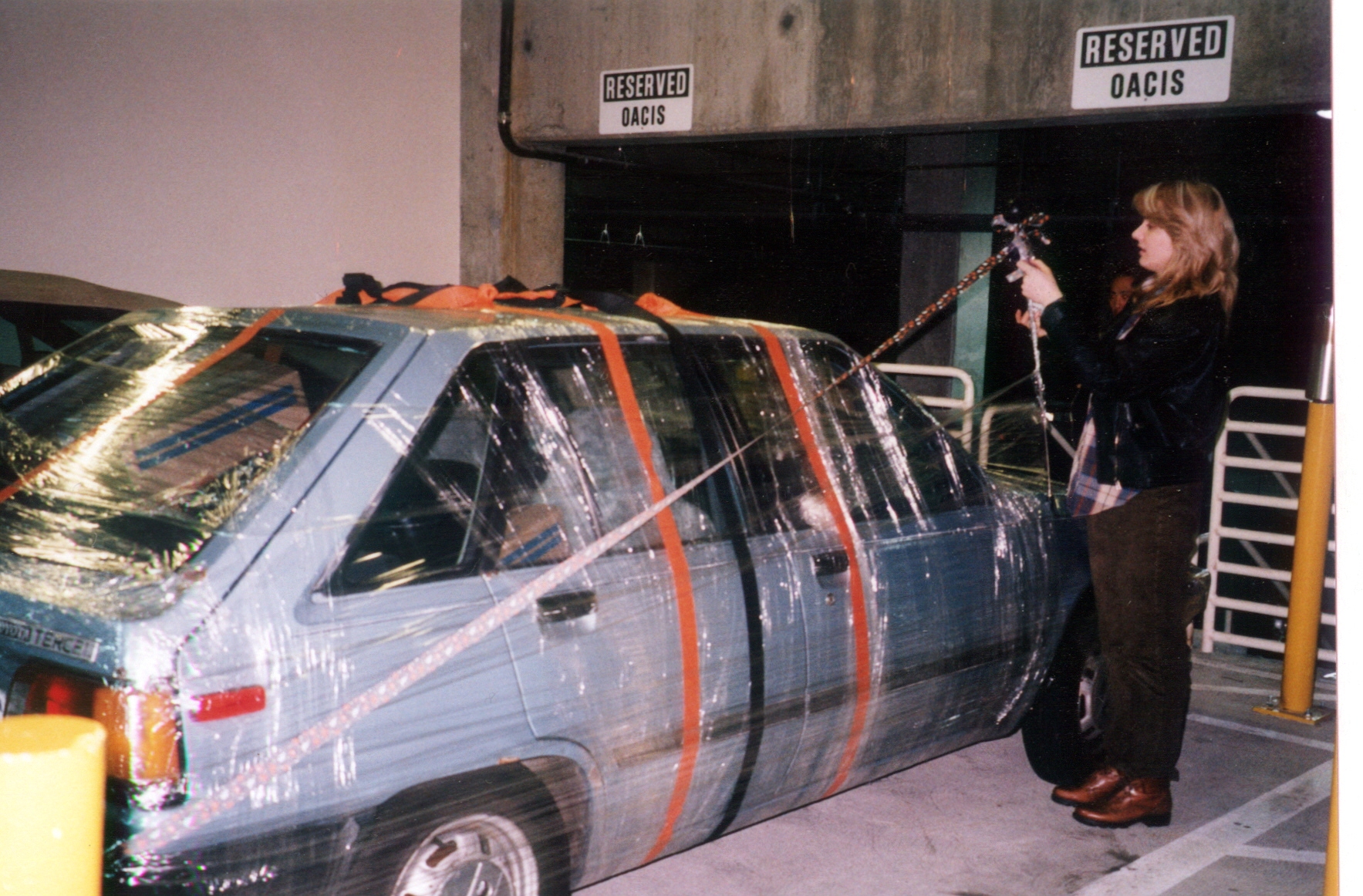 As a parting gift when I left Oacis in 1999, my fellow engineers saran wrapped my car.
As a parting gift when I left Oacis in 1999, my fellow engineers saran wrapped my car.I once found a bug in the Sun OS kernel. It took me numerous attempts to get Sun to believe it wasn't operator error.
I was fortunate to be at the right place at the right time to be a founding member of an R&D department of a new high tech company, Fast Track Systems, at the height of the dot com boom in 1999. I was looking for work at the time, and it was so crazy, I had about 10 job offers. Currently only 2 of those companies still exist (the other was Autodesk).
And via Fast Track, I've lived the high-tech American Dream of actually cashing in my stock options, after Fast Track was sold to another high-tech company, Medidata Solutions in NYC. It didn't make me a millionaire, but I'm not complaining.
Epilogue
While writing and assembling the photos for this little summary, it felt remarkably poignant how quickly 30 years go by. I began my software career as a young man...and now, I'm not so young a man, but by no means ready for the retirement condo in Bakersfield. I can't think of another field that has been so vibrant and expansive as the high tech field. After 30 years, I still feel challenged. Come to think of it, I learn something new just about every working day of my life. That, to me, is a testament of the dynamic quality of this field, it keeps me on my toes, keeps me interested, inspired, curious, or full of, as they say in Zen "beginner's mind" - even though I've amassed a great deal of information and experience, I'm humbled by how little I still know, and feel fortunate to have worked with so many brilliant technical minds and results-driven hard workers. Working with people can be maddening at times, and working with computers can be equally maddening for a very different reason - they do exactly what you tell them to do, and often it's not clear enough, with disastrous results. Like working with total idiots.
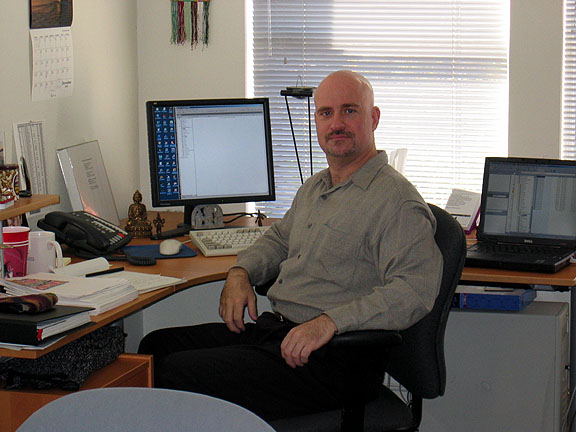 Fast Track Systems startup, 1994. I look kinda stiff no?
Fast Track Systems startup, 1994. I look kinda stiff no?And I've often thought, 'what if I hadn't made that phone call, that day at that time? Where would I be?'. If it wasn't made, I probably would have had a very different destiny - meeting my wife, my life here in California and all of the other places I have lived were a function of people, places and events tied to my working in the software field.
And it begs the question, 'was "I" responsible for that idea to make that phone call at that very moment?'. Not really..all sorts of thoughts, feelings and ideas pass through the mind everyday, and it our responsibility to sift through all that arises in mind everyday and determine which ones to act on...and when to act. As a basic barometer, one has to trust a much deeper, silent intuition as to how to act in this world. Weird as it may sound, I use my gut as much as I use my noggin' to work in the computer field. The proverbial flash of insight or gut feeling to solve a gnarly, longstanding problem or bug comes spontaneously and mysteriously - sometimes in the middle of the night, sometimes even in a dream!
 Here's me in 2012. All a developer needs these days is a mac laptop and VPN connection to the cloud.
Here's me in 2012. All a developer needs these days is a mac laptop and VPN connection to the cloud.Clearly, if there is such a thing as destiny, my work in this field was something that I was meant to do. I just had to wait a bit for the computer world to come out of its infancy. When it did, I was right there, ready for my first job. And since then, I've been a witness and an active participant in a number of evolutionary leaps and paradigm shifts in the computer and high tech field. There's a great deal in store in the future as software moves into more fields and becomes more of a staple, a ubiquitous tool that we use to enhance our lives in numerous ways.
I'm looking forward to the what the future in high-tech brings and if the previous decades are any indication, it'll be a helluva ride.
Ciao!